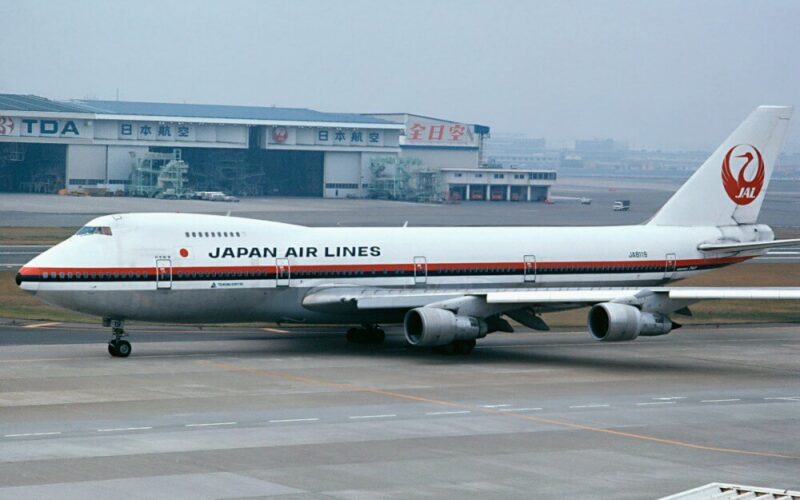August 12, 2020, marks the tragic 35 year anniversary of Japan Airlines Flight 123 crash, the deadliest single-aircraft accident in aviation history, in which 520 people lost their lives.
The Crash
On August 12, 1985, a Japan Airlines Boeing 747SR, en route from Tokyo’s Haneda Airport (HND) to Osaka International Airport (ITM), declared an emergency 12 minutes into the flight before crashing near Mount Takamagahara 32 minutes later.
The aircraft took off from Haneda, flown by Captain Masami Takahama and First Officer Yutaka Sasaki, and not even 15 minutes into the flight suffered sudden decompression and breakage of the ceiling near lavatories, damaging the plane’s unpressurized fuselage aft, unseating the vertical stabilizer and severing all four hydraulic lines.
After losing hydraulic control, the 747 began oscillating in phugoid cycles that lasted about 90 seconds each. Without its stabilizer, the aircraft also had virtually no yaw stability, sending the entire jet into a series of Dutch rolls from left to right, with each repetition lasting about 12 seconds.
Unpressurized, the 747 stayed fluctuating in an altitude range of 20,000–24,000 feet (6,100–7,300 m) for an entirety of 18 minutes. The pilots found the entire situation almost impossible to comprehend, struggling to figure out how to descend the aircraft without flight controls. Most likely, their impaired cognitive abilities resulted from their bodies being deprived of oxygen at such altitude. The voice recordings from the flight suggested that neither of the pilots wore oxygen masks since their voices could be heard clearly.
Minutes before the 747 crashed near Mount Takamagahara, the pilots tried to stabilize the aircraft by performing a series of rapid thrusts but with little effect. In the recording, the last moments before impact could be heard when Captain Takahama exclaimed to communications, “We cannot do anything now!” after the pilots’ final futile attempts at raising the aircraft. Upon impact, the 747SR exploded.
The Overdue Rescue
After the crash, a United States Air Force navigator stationed at Yokota Air Base claimed to have monitored the distress call and prepared search and rescue operations when it was still daylight but was called off by the Japanese authorities. The personnel at Yokota remained on standby 20 minutes after the incident but did not receive permission to aid the crash-landed.
After nightfall, a Japan Self-Defense Forces (JSDF) helicopter spotted the crash site but was unable to land due to poor visibility and the mountainous terrain. The pilot reported seeing no signs of survivors from the air, and JSDF personnel were dispatched to prepare a search the next morning.
Medical staff had found four survivors out of 524 passengers in the debris. They had also identified bodies with such injuries that suggested many had died from shock and overnight exposure. One doctor said, “If the discovery had come ten hours earlier, we could have found more survivors.”
Yumi Ochiai, one of the four survivors, said she recalled bright lights and helicopter sounds shortly after waking up amidst the wreckage. She could hear screaming and moaning from other survivors, but the sounds gradually died away throughout the night.
The Cause
According to an official report published by Japan’s Aircraft Accident Investigation Commission, the aircraft was involved in a tailstrike incident seven years earlier. During this incident, the aircraft aft pressure bulkhead was damaged and its repairs did not conform to Boeing’s approved methods.
To reinforce the bulkhead, the technicians used two splice plates instead of one spice plate with three rows of rivets. The bulkhead’s resistance to wear and tear was a mere 70% of its original capacity. During the investigation, the Commission calculated that this incorrect fix would fail after 10,000 pressurization cycles and the aircraft completed 12,318 flights following the defective overhaul.
Consequently, after many flights, the bulkhead began to crack near one of the two rows of rivets that held it together. And when it failed and resulted in rapid decompression, this ruptured all four hydraulic systems and ejected the vertical stabilizer, rendering the aircraft uncontrollable.
The Aftermath
After the crash, Japan Airlines did not take direct liability for the tragedy and labeled it as an “accident”. The company paid 780 million yen ($7.6 million) to the victims’ families not as compensation but as “condolence money.” However, its reputation tanked a drop of 25% decrease in domestic traffic since most people switched to All Nippon Airways for a “safer alternative.”
In the aftermath of Japan Airlines flight 123 crash, the company’s president Yasumoto Takagi had resigned from his post. The company’s maintenance manager, Hiroo Tominaga, committed suicide to atone for the tragic event. Susuma Tajima, the engineer who checked and cleared the 747SR for takeoff before its final flight, also took his own life after the crash.

